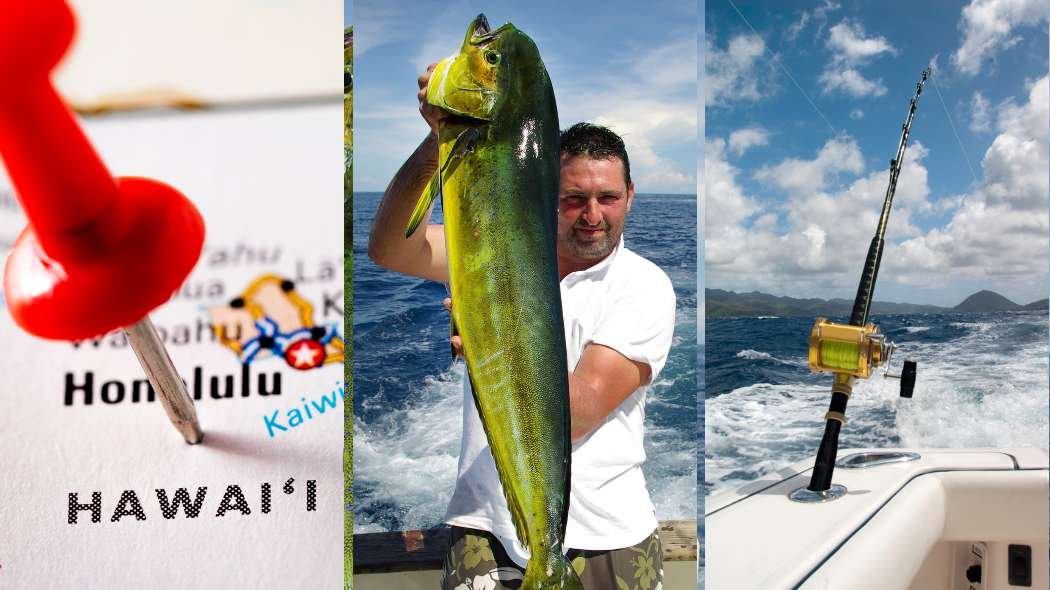Mahi Mahi Fishing in Hawaii: Peak Season, Charters + Prices
Aloha! Are you ready to explore the thrilling world of Mahi Mahi fishing in Hawaii? In this article, we’ll dive into the ins and outs of catching these alluring fish in the warm, abundant waters of the Hawaiian Islands.
Hawaii is famous for its remarkable beauty, rich culture, and of course, Mahi Mahi fishing. Also known as Dolphin fish or Dorado, Mahi Mahi are known for their stunning colors and mind-blowing acrobatics, making them a prime target for sportfishing enthusiasts and food lovers alike.
In this guide, you’ll discover everything you need to know about Hawaii‘s Mahi Mahi fishing scene, including:
- Characteristics of Mahi Mahi and their habitats
- Seasonality and prime times for Mahi Mahi fishing in Hawaii
- Techniques, gear, and tips to catch these majestic creatures
- Top Mahi Mahi charter options in Hawaii
- Sustainability and responsible fishing practices
- How to prepare and enjoy Mahi Mahi as a delicious and nutritious meal
Mahi Mahi Characteristics
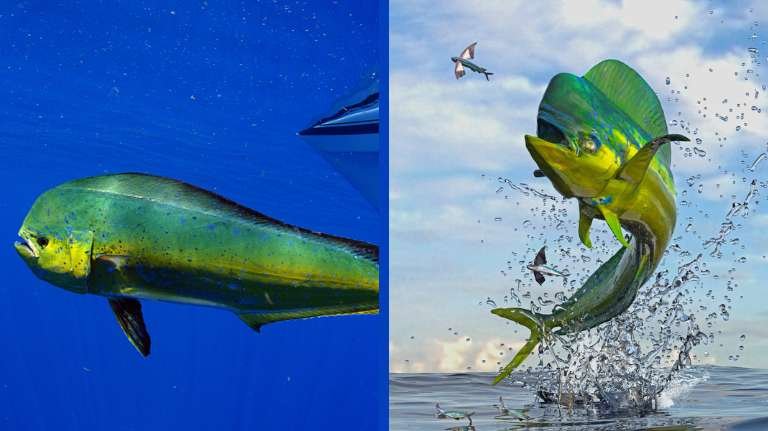
Mahi Mahi boast a striking appearance, with a golden body and vibrant shades of green and blue adorning their sides. Keep in mind that their colors fade after death, so when catching them, you’ll want to cherish those moments when their colors are at their peak.
Here’s a quick overview of their prominent features:
- A large, blunt head with a distinct dorsal fin running the length of their body
- A forked and slender caudal fin for powerful, agile swimming
- Wide, round pectoral fins supporting their impressive jumps and flips
When hooked, Mahi Mahi showcase an incredible array of blues, yellows, greens, and red dots, making them one of the most beautiful game fish out there. They are known to leap and flip out of the water, providing a thrilling experience for the angler.
Mahi Mahi size and weight can vary, but in Hawaiian waters, they typically average around 20 pounds. However, these magnificent fish can reach up to a staggering 82 pounds! Despite their beauty, these fish are no pushovers. They put up an exhilarating fight, making their capture even more rewarding.
Habitat and Behavior
Mahi Mahi are pelagic fish, which means they prefer the open ocean and are often found far from the shore. They love warm, tropical waters, which makes the Hawaiian Islands a perfect playground for them.
When it comes to specific behavioral traits, here are a few noteworthy points:
- They often swim in schools, making it possible to find a group of them while fishing
- Younger fish tend to stay close to seaweed or other debris for protection
- Mature Mahi Mahi usually inhabit greater depths, roaming near weed lines, floating structures, and food-rich oceanic currents
Mahi Mahi also thrive in the warm waters of the Atlantic, Pacific, Indian Ocean, and the Mediterranean Sea.
Some sought-after locations for Mahi Mahi fishing include Mexico, Florida, Guatemala, the Dominican Republic, and of course, Hawaii.
Approaches may vary regionally, but some standard methods include trolling, casting, jigging, spinning, and using live or dead bait to entice these beautiful fish.
Mahi Mahi Peak Seasons in Hawaii

Although you can find Mahi Mahi in Hawaiian waters year-round, there are specific periods when their abundance peaks, making your fishing experience that much more exhilarating.
While the exact peak seasons for Mahi Mahi fishing in Hawaii can vary across the islands, generally, you can expect increased activity during the following times:
- Spring: March to May marks a significant upswing in Mahi Mahi presence, as the warmer weather and ample food availability attract these feisty fish.
- Fall: Another spike in Mahi Mahi fishing occurs from September to November, providing anglers with another promising window to secure a prized catch.
Even though these months are considered the peak seasons, remember that Mahi Mahi are still around in other months, just in lower numbers.
While the peak seasons offer the best opportunities to land a coveted Mahi Mahi, the Hawaiian Islands are blessed with a climate and ecological conditions that make Mahi Mahi fishing possible all year. So, regardless of when you visit, there’s always a chance to reel in one of these amazing fish. Just be prepared that the experience might be a bit more challenging during the off-peak months.
Fishing Techniques, Gear, Lures and Bait for Dolphin Fish

When embarking on a dolphin fish adventure in Hawaii, it’s essential to be equipped with the right gear and techniques. This section will provide valuable information on how to effectively lure and catch this vibrant and acrobatic fish.
Trolling is a popular method of targeting Mahi Mahi, as it covers a larger area and increases the chances of finding them. Here’s a list of necessary trolling gear and lures to consider:
- Heavy action rods: Choose rods with a good backbone to handle the strength of these fast and powerful fish.
- Braided or fused lines: Look for lines with a strength of 30-80 pounds that can withstand the Mahi Mahi’s powerful fight.
- Lures: Opt for diving plugs, artificial squid, and colorful feathered lures that mimic the Mahi Mahi’s prey.
Mahi Mahi are carnivorous fish with a taste for specific baits. The following are their preferred live baits:
- Ballyhoo
- Cut fish
- Squid
Using live bait when trolling adds another level of excitement and a more realistic presentation that can entice the Mahi Mahi.
Mahi Mahi are known to be attracted to floating objects and disturbances on the water surface. Keep an eye out for the following signs:
- Seaweed lines: Mahi Mahi often reside near seaweed where their prey such as flying fish and crabs can be found.
- Floating structures: Debris and other floating objects provide shelter for smaller baitfish – which in turn, attract the Mahi Mahi.
- Bird activity: The presence of birds diving into the water may indicate a school of Mahi Mahi feeding on fish below the surface.
Creating commotion on the water surface using lures or trolling techniques, combined with the natural elements mentioned above, can significantly increase your chances of locating and catching Mahi Mahi in the beautiful waters of Hawaii
Mahi Mahi Fishing Charters in Hawaii
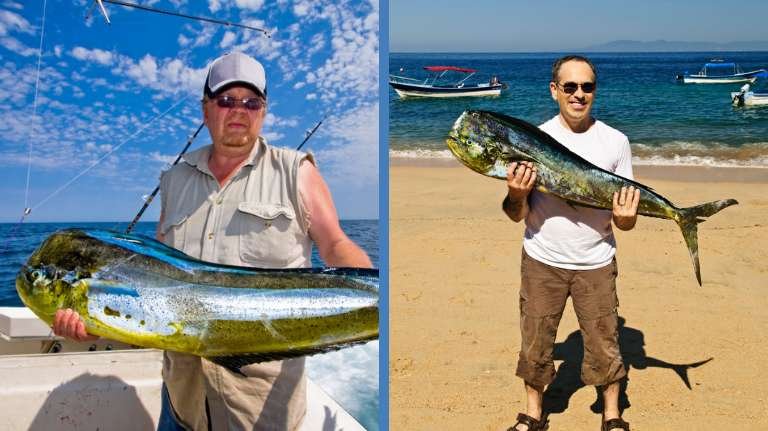
Hawaii’s captains and boat crew can offer you an unforgettable experience to indulge in the thrill of catching impressive game fish. Explore various options to suit your preferences and budget, ensuring an exciting and valuable adventure on Hawaiian waters. Each charter offers experienced captains, comfortable boats, and a wide range of fishing adventure options.
Ocean Addict Hawaii boasts over 20 years of experience and provides comfort, reliability, and the most knowledgeable captains on the North Shore of Oahu. They offer half-day, full-day, and customized trips tailored to your preferences while targeting species such as Mahi Mahi, Great Barracuda, Striped Marlin, and Rainbow Runner. With a spacious 36-foot Hatteras offshore sportfishing boat equipped with modern amenities like GPS, fishfinder, and a toilet, Ocean Addict Hawaii ensures a fantastic fishing experience in Haleiwa.
To The Max Charters operates from Haleiwa and offers everything from half-day to full-day fishing trips. Their expert captains are familiar with local waters, ensuring productive outings to catch Mahi Mahi, Blue Marlin, Giant Trevally, and more. The 30-foot Bertram sport fisher promises a comfortable and exciting day on the water, complete with navigational electronics and a private toilet. To The Max Charters provides quality fishing tackle, allows swimming, and welcomes kids of all ages.
Ohana Yacht specializes in luxurious fishing trips aboard their 74-foot Striker motor yacht in Honolulu. With a yacht accommodating up to 12 guests, it’s perfect for group outings. Ohana’s comprehensive navigation technology and onboard facilities, including a toilet, shower, kitchen, and air conditioning, guarantee a comfortable adventure at sea. Captain Kyle Kim’s 17 years of experience, coupled with quality fishing gear, ensure an exceptional experience targeting Mahi Mahi, Blue Marlin, Wahoo, and Skipjack Tuna.
One popular fishing charter provider in Hawaii is Whipsaw Sportfishing, located in Honolulu. Known for their experienced crew and well-maintained boats, they cater to anglers of all skill levels seeking Mahi Mahi fishing adventures.
No matter which charter you choose, remember to inquire about the specific amenities, pricing, and booking requirements.
Pricing and Charter Options
Hawaii’s fishing charters generally offer a range of options, from shared charters to private charters, accommodating different group sizes and budgets. They typically provide:
- Half-day charters
- Three-quarter day charters
- Full-day charters
Average prices for Mahi Mahi fishing charters in Hawaii:
| Charter Type | Approximate Price |
|---|---|
| Half-Day | $570 to $620 |
| 3/4 Day | $850 to $960 |
| Full-Day | $1,080 to $2,100 |
Keep in mind that prices vary depending on the charter company, boat size, amenities, and the time of the year.
Fishing License Requirements
When you book a fishing charter in Hawaii, there’s no need to worry about purchasing a separate fishing license. The boat’s captain typically covers the licensing requirements for all passengers on board.
To make the most of your adventure, be sure to choose a reputable and experienced charter company. They’ll provide you with valuable guidance, fishing expertise, and even share their favorite techniques to increase your chances of hooking a memorable catch.
Sustainability of Dorado Fishing
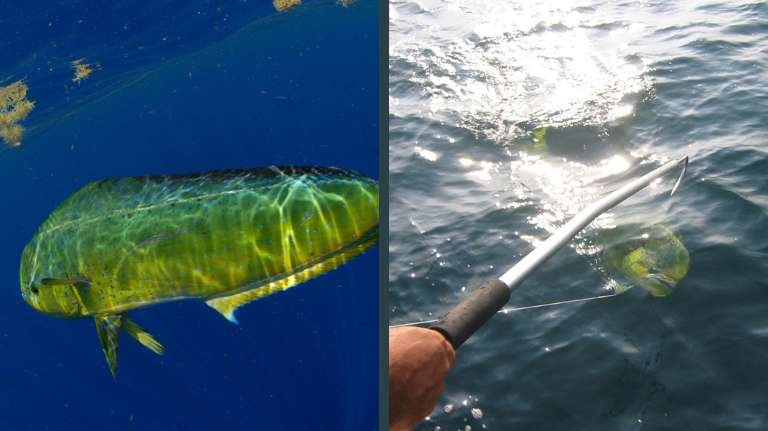
It’s crucial that we prioritize sustainability to maintain healthy oceans and thriving fish populations. Let’s explore the wonderful realm of sustainable dorado fishing practices in Hawaii and the efforts in place to protect this precious resource.
In Hawaii, responsible fishing practices are at the forefront of the industry. Some of these practices include:
- Implementing seasonal restrictions to allow for Mahi Mahi to reproduce and grow during specific periods.
- Utilizing proper catch-and-release techniques to maintain healthy fish populations.
- Adhering to established bag limits and size restrictions for recreational anglers.
These sustainable practices are not only beneficial for the dorado populations but also uphold an ecological balance by preserving marine ecosystems.
Efforts to manage and conserve fish populations in Hawaii are made by local, federal, and international organizations. Some of these initiatives include:
- Hawaii-Seafood.org: This organization provides resources on responsible fishing practices, seafood safety, and the nutritional benefits of eating Mahi Mahi, among other information.
- NOAA’s FishWatch.gov: FishWatch provides information on the sustainability of Mahi Mahi fishing in Hawaii, as well as details on catch statistics and regulations.
Through these organizations and other partners, a sustainable fishing culture is promoted in Hawaii, ensuring future generations can continue to enjoy the thrill of fishing.
So, my adventurous reader, as you embark on your fishing trip, remember the importance of practicing sustainable fishing techniques. Hawaii’s efforts in maintaining a delicate balance between fulfilling our appetites and preserving the marine ecosystem showcase the love and care for their natural resources. Let’s all pitch in to protect our oceans and the spectacular lifeforms within them.
Mahi Mahi as a Food
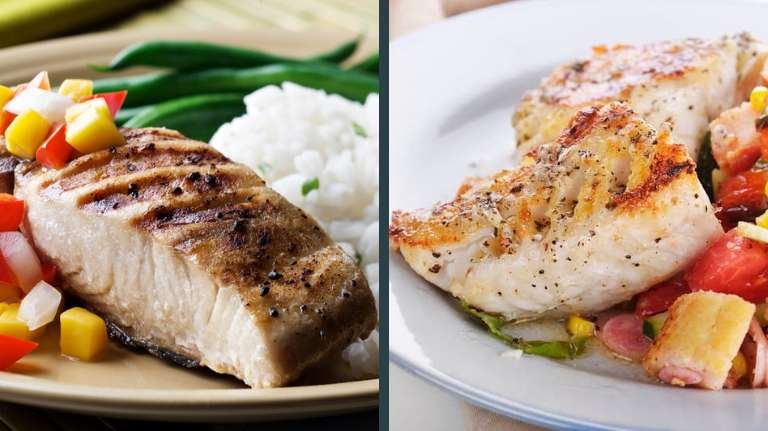
Delight your palate with the deliciously versatile dorado. This popular fish, sought after by culinary enthusiasts and home cooks alike, offers a wealth of culinary possibilities. Let me guide you through the essentials of savoring this irresistible ocean gem.
Indulge in the goodness of Mahi Mahi as it serves as an excellent source of lean protein. Packed with essential vitamins and minerals, it enriches your diet with Omega-3 fatty acids, Vitamin B, and potassium. Savoring its mildly sweet and subtle flavor, you’ll find Mahi Mahi’s pink, tender meat turns a succulent white when cooked.
Cooking Methods and Recipes
Mahi Mahi’s firm texture and mild taste make it a versatile choice for various cooking methods. Try out these delightful ways to enjoy the fish:
- Grilling: Enhance its natural flavors over open flames, creating appetizing grill marks.
- Broiling: Quickly cook it at a high temperature to achieve a tempting golden crust.
- Pan-frying: Sauté on medium heat for a crispy, delectable exterior while retaining its delightful tenderness inside.
Unleash your culinary creativity with these enticing recipe ideas:
- Mahi Mahi tacos: Combine perfectly flaked grilled Mahi Mahi with zesty lime slaw for a scrumptious twist on classic tacos.
- Blackened Mahi Mahi: Spice things up by dredging your fillets in a delectable mix of paprika, cayenne pepper, and other herbs before searing in a hot pan.
- Mahi Mahi with tropical salsa: Pair your perfectly cooked fish with a vibrant, fruit-forward salsa featuring mango, pineapple, or papaya.
Mercury Levels and Food Handling Tips
While Dolphin Fish showcases numerous health benefits, be mindful of its moderate mercury levels. To enjoy it responsibly, follow these guidelines:
- Adults: Consume up to two servings of Mahi Mahi per week.
- Children: Limit to one serving per week, with smaller portion sizes.
To ensure the utmost quality and safety when eating fish, follow these essential food handling and storage tips:
- Refrigerate: Store fresh, uncooked Mahi Mahi in the coldest part of your refrigerator at 32°F (0°C) for up to two days.
- Freeze: Wrap your Mahi Mahi tightly in plastic wrap or use vacuum-sealed bags, then store it in the freezer at 0°F (-18°C) for up to six months.
- Prevent Scombroid Fish Poisoning: Proper refrigeration is crucial, as improper storage can result in scombroid fish poisoning. Symptoms may include vomiting, rash, and diarrhea.
Embrace the versatility and delightful taste of the dolphin fish, experiment with various recipes, and most importantly, enjoy the culinary adventure.

